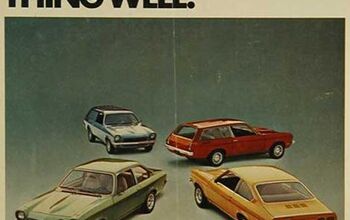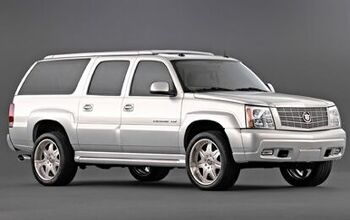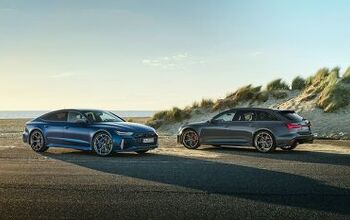Detroit Deathwatch – The Prequel (Part 1)

When a chain smoker develops lung cancer after thirty years of habitual self-annihilation, their ill-health should come as no surprise to either the smoker or a casual observer. Likewise, The Big 2.5’s current tailspin is the direct result of bad habits stretching back some fifty years. Like a pack-a-day puffer, the Detroit automakers “felt just fine” for several decades. Eventually, inevitably, their dirty little habits caught up with them.
In the 1950’s, The Big Three rode America’s post-war economic boom to unprecedented profits. Their seemingly unstoppable success crowded out the domestic competition (Hudson, Nash, Packard, Studebaker). The Detroit capos reigned supreme, addicted to the high profits generated by a one-size fits-all strategy. So they cranked out nothing but full-size cars and trucks, counted the cash, paid off the unions, sat back and enjoyed the view. After all, why do anything different when the sun’s shining and hay’s being made?
The annual model change summoned forth more fins, chrome and horsepower– while hiding undersized drum brakes, marshmallow handling, numb steering and declining efficiency. While there were moments of brilliance amid the glitz and glamour, The Big Three decided Americans were suckers for sheer size and superficial flash.
Despite the eternal sunshine of Detroit’s spotless minds, European import cars started trickling into the domestic arena. By the late 50’s, the trickle had become a torrent. Corner car lots sold every conceivable (if obscure) European make: two-stroke DKWs, two-cylinder Lloyds, Renault Dauphines, Hillman Minx, Austins, Simcas, Peugeots, Citroens, VWs, Mercedes, Borgwards, etc. The Big Three launched their first counterattack in 1960.
Enter the Falcon, Corvair, Valiant and later, Chevy II. They were mostly seven-eighths scale full-size cars; vehicles that shared as many components with their bigger brothers as possible. The end result had certain relative merits, but import-style steering feel, handling and efficiency were not amongst them.
The new compacts sold well enough. Sales of “exotic” imports imploded in 1960– and no wonder. By then, most of the fragile machines were either dead or falling by the roadside. VW and Mercedes were a notable exception, importing robust cars within a proper dealer network. But the rest of them weird ferrin jobs couldn’t withstand American-style driving abuse—long distances and minimal maintenance. The lack of parts and service from fly-by-night dealers didn’t help.
The Big Three misread the tea leaves– they saw their compacts’ success and the collapse of import sales as complete vindication.
In Detroit’s mid-sixties’ euphoria, the domestics failed to notice that VW’s reputation and sales continued to grow. Soon, they were closing in on half a million sales per year. In fact, The Big Three’s compacts were stealing sales from the compact Rambler American and Studebaker Lark and their own land yachts– not the sturdy little German cars.
Anyway, the U.S. market was expanding so rapidly that the domestic compacts’ failure to stem the import tide was lost on their creators. Falling back on old habits, they put their compacts on a super-size V8 Juice diet.
By the late 60’s, Fort Detroit once again became aware of the foreign invaders. There were termites in the walls– VW bugs– and the sound of their collective chewing could not be ignored. At the same time, Toyota and Nissan put their heads over the parapet.
GM and Ford responded with a salvo of four cylinder compacts: the 1971 Chevy Vega and Ford Pinto. We’ll dispense with all the old jokes. Let’s just say that one nadir attracted another. Never mind the Pinto’s exploding gas tanks and the Vega’s self-destructing engines (aluminum block with cast iron head?), the terrible 2+2-some were packaging efficiency anti-matter.
At least the Vega handled well. Customers looking for a shrunken Camaro with a suicidal, gutless tractor engine, a three-speed stick (or two-speed Power-Glide) and interiors with all the ambience of a Rubbermaid storage bin loved it. Chrysler’s solution– The Plymouth Cricket (the imported English Hillman)– was no better, and a lot worse.
Meanwhile, Nissan had a hit with its Datsun 510, the “poor man’s BMW.” The Japanese import boasted a lusty OHC four, slick transmission, independent rear suspension and a practical but good-looking body. Toyota’s Corona was a little more boring (the company DNA?) but sturdy and fully equipped.
Never mind. The Big Three entered the 1970’s brimming with confidence. Their all-new ‘71 big cars were the pinnacle (and blow-out) of the American car’s evolution– from the 1200lb Model T to 5000+lb big-block barges longer than a Suburban.
Detroit firmly believed that the cute-as-a-bug Vega and um, inexpensive Pinto would finally show those nasty, cheap, tinny little imports what for. Once again, the big boys in and around Detroit convinced themselves that they had dealt with a problem that would eventually go away, just like the last time.
Cigars were passed. Kool-Aid drunk. A reckoning was on its way.

More by Paul Niedermeyer
Latest Car Reviews
Read moreLatest Product Reviews
Read moreRecent Comments
- ToolGuy 9 miles a day for 20 years. You didn't drive it, why should I? 😉
- Brian Uchida Laguna Seca, corkscrew, (drying track off in rental car prior to Superbike test session), at speed - turn 9 big Willow Springs racing a motorcycle,- at greater speed (but riding shotgun) - The Carrousel at Sears Point in a 1981 PA9 Osella 2 litre FIA racer with Eddie Lawson at the wheel! (apologies for not being brief!)
- Mister It wasn't helped any by the horrible fuel economy for what it was... something like 22mpg city, iirc.
- Lorenzo I shop for all-season tires that have good wet and dry pavement grip and use them year-round. Nothing works on black ice, and I stopped driving in snow long ago - I'll wait until the streets and highways are plowed, when all-seasons are good enough. After all, I don't live in Canada or deep in the snow zone.
- FormerFF I’m in Atlanta. The summers go on in April and come off in October. I have a Cayman that stays on summer tires year round and gets driven on winter days when the temperature gets above 45 F and it’s dry, which is usually at least once a week.


































Comments
Join the conversation
This post strikes me as cliche mongering. The '55 - '57 Chevy only weighed 3300lbs - that's what a Camry weighs now - and Chevy had a sterling reputation for build quality and stellar resale value that lasted throughout the '60's. I think the problem with this post is it conflates three different decades and tries tying them all together and tars them with the same broad brush strokes.
KingElvis: The '77 Impala sedan weighed 3564 lbs. Close enough ("within 200 lbs")?